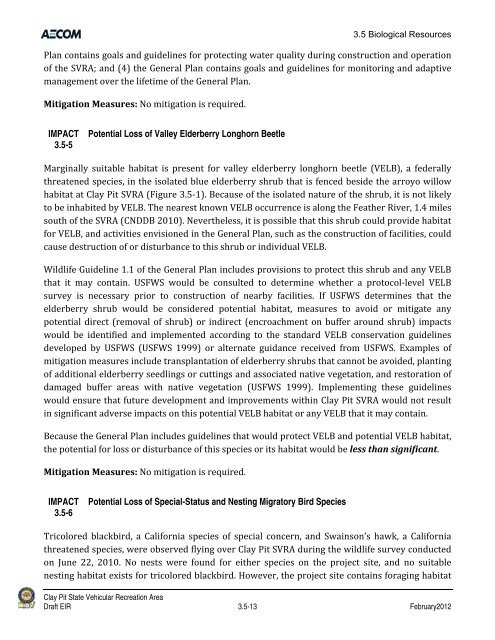Draft Environmental Impact Report - California Off Highway Vehicle ...
Draft Environmental Impact Report - California Off Highway Vehicle ...
Draft Environmental Impact Report - California Off Highway Vehicle ...
Create successful ePaper yourself
Turn your PDF publications into a flip-book with our unique Google optimized e-Paper software.
3.5 Biological Resources<br />
Plan contains goals and guidelines for protecting water quality during construction and operation<br />
of the SVRA; and (4) the General Plan contains goals and guidelines for monitoring and adaptive<br />
management over the lifetime of the General Plan.<br />
Mitigation Measures: No mitigation is required.<br />
IMPACT<br />
3.5-5<br />
Potential Loss of Valley Elderberry Longhorn Beetle<br />
Marginally suitable habitat is present for valley elderberry longhorn beetle (VELB), a federally<br />
threatened species, in the isolated blue elderberry shrub that is fenced beside the arroyo willow<br />
habitat at Clay Pit SVRA (Figure 3.5‐1). Because of the isolated nature of the shrub, it is not likely<br />
to be inhabited by VELB. The nearest known VELB occurrence is along the Feather River, 1.4 miles<br />
south of the SVRA (CNDDB 2010). Nevertheless, it is possible that this shrub could provide habitat<br />
for VELB, and activities envisioned in the General Plan, such as the construction of facilities, could<br />
cause destruction of or disturbance to this shrub or individual VELB.<br />
Wildlife Guideline 1.1 of the General Plan includes provisions to protect this shrub and any VELB<br />
that it may contain. USFWS would be consulted to determine whether a protocol‐level VELB<br />
survey is necessary prior to construction of nearby facilities. If USFWS determines that the<br />
elderberry shrub would be considered potential habitat, measures to avoid or mitigate any<br />
potential direct (removal of shrub) or indirect (encroachment on buffer around shrub) impacts<br />
would be identified and implemented according to the standard VELB conservation guidelines<br />
developed by USFWS (USFWS 1999) or alternate guidance received from USFWS. Examples of<br />
mitigation measures include transplantation of elderberry shrubs that cannot be avoided, planting<br />
of additional elderberry seedlings or cuttings and associated native vegetation, and restoration of<br />
damaged buffer areas with native vegetation (USFWS 1999). Implementing these guidelines<br />
would ensure that future development and improvements within Clay Pit SVRA would not result<br />
in significant adverse impacts on this potential VELB habitat or any VELB that it may contain.<br />
Because the General Plan includes guidelines that would protect VELB and potential VELB habitat,<br />
the potential for loss or disturbance of this species or its habitat would be less than significant.<br />
Mitigation Measures: No mitigation is required.<br />
IMPACT<br />
3.5-6<br />
Potential Loss of Special-Status and Nesting Migratory Bird Species<br />
Tricolored blackbird, a <strong>California</strong> species of special concern, and Swainson’s hawk, a <strong>California</strong><br />
threatened species, were observed flying over Clay Pit SVRA during the wildlife survey conducted<br />
on June 22, 2010. No nests were found for either species on the project site, and no suitable<br />
nesting habitat exists for tricolored blackbird. However, the project site contains foraging habitat<br />
Clay Pit State Vehicular Recreation Area<br />
<strong>Draft</strong> EIR 3.5-13 February2012








